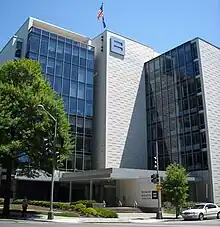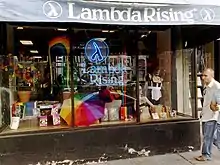LGBT culture in Washington, D.C.
In Washington, D.C., LGBT culture is heavily influenced by the U.S. federal government and the many nonprofit organizations headquartered in the city.
.jpg.webp)
Demographics
From 2015 to 2016, Gallup polling reported that 8.6% of District of Columbia residents identified as lesbian, gay, bisexual, or transgender (LGBT), a higher percentage than any U.S. state.[1]
There are an estimated 209,000 LGBT people living in the broader Washington metropolitan area, making up 4.5% of the population.[2] The Census Bureau reported that there were 6,935 same-sex households in Washington, D.C., in 2018, of which 61% were same-sex spouses.[3] In 2017, 2.9% of all households were same-sex couple households. 77.4% of these households were male couples.[4]
History
1950s and 1960s
Starting in 1950, in parallel to McCarthyism, the "Lavender Scare" resulted in the firing of thousands of government employees and contractors who were believed to be gay or lesbian, on the grounds of a tenuous perceived connection between homosexuality and espionage. Washington, D.C. vice squad lieutenant Roy Blick asserted to the Senate without evidence that there were 5,000 homosexual government employees. In 1961, following the Lavender Scare, Frank Kameny and Jack Nichols founded the Washington chapter of the Mattachine Society, adapting tactics learned from the civil rights movement and organizing pickets at the White House, Pentagon, and State Department.[5]
1970s and 1980s
In 1970, activists from the civil rights movement, antiwar movement, and Black Panthers created the Gay Liberation Front-DC. The group staged public demonstrations and helped organize Washington's first gay pride in May 1972. The festival took place in Lafayette Park and at George Washington University and featured a dance, a drag show, and a religious celebration.
In 1971, Kameny ran unsuccessfully in the 1971 District of Columbia's at-large congressional district special election.
The Furies Collective, a lesbian feminist collective whose members included Rita Mae Brown and Joan E. Biren, pressured the National Organization for Women to accept lesbians in the early 1970s.
A former member of the Gay Liberation Front-DC, Deacon Maccubbin, opened Lambda Rising in 1974. The now-defunct bookstore was one of the United States' largest gay bookstores and provided a space for other community groups. Maccubbin organized the first official DC gay pride in 1975.
In 1979, students at Howard University created the Lambda Student Alliance, the first organization for LGBT students created at a historically black college or university. In October the same year, the National Third World Lesbian and Gay Conference took place at an unknown hotel near the university, coinciding with the first National March on Washington for Lesbian and Gay Rights.
In 1982, James Tinney created Faith Temple to cater to LGBT Christians.[6][7]
The Second National March on Washington for Lesbian and Gay Rights was a large political rally that took place in Washington, D.C., on October 11, 1987.
The AIDS Memorial Quilt, originally created by Cleve Jones in response to the assassination of Harvey Milk was displayed on the National Mall in 1987.[8]
1990s and 2000s
.jpg.webp)
The March on Washington for Lesbian, Gay and Bi Equal Rights and Liberation in 1993 generated widespread attention and included a performance by Melissa Etheridge. The 1993 march was organized by Urvashi Vaid, the president of the National Gay and Lesbian Task Force. According to Joan E. Biren, this was the first time Jumbotrons were set up on the National Mall aside from government-organized events.[8]
The Millennium March on Washington was an event to raise awareness and visibility of lesbian, gay, bisexual and transgender (LGBT) people and issues of LGBT rights in the US, it was held April 28 through April 30, 2000.
The National Equality March was a national political rally that occurred October 11, 2009 in Washington, D.C.
2010s and 2020s
In 2015, following the U.S. Supreme Court rulings that states must recognize same-sex marriages, the White House was lit in with the colors of the Pride flag.[9]
.jpg.webp)
In 2017, protesters with No Justice No Pride blocked the Capital Pride Parade near 15th Street NW and P Street NW. The group opposed Capital Pride's corporate sponsorship and cooperation with police, and accused the event of marginalizing minorities. The parade was re-routed onto 16th Street NW and towards Rhode Island Avenue, while Police allowed the group to continue protesting with no arrests.[10]
The National Pride March took place on June 11, 2017 alongside Capital Pride. Marchers walked past the White House towards the U.S. Capitol.[11]
Neighborhoods
Dupont Circle
.jpg.webp)
The Dupont Circle neighborhood is a historical hub of LGBT life in Washington D.C. The area hosts several LGBT events, including the 17th Street High Heel Race and the Capital Pride Parade. The neighborhood also has several gay bars, including JR's. A stretch of 17th Street NW is named in honor of Frank Kameny.[12] Before closing in 2010, the Lambda Rising bookstore was located on Connecticut Avenue NW.[7]
The Gay Way
The neighborhood around 8th Street Southeast was the location of many LGBT establishments from the 1960s through the 1980s and became known as "The Gay Way." Following riots in 1968, 8th Street became a hub for LGBT culture, including lesbian bars Phase 1, Jo-Anna's, and Club Madame. As the area gentrified in the 2000s, many LGBT establishments closed. [13]
Organizations and community institutions

Many LGBT nonprofit organizations have headquarters in Washington, D.C., including:
- Human Rights Campaign
- LGBTQ Victory Fund
- National Center for Transgender Equality
- National LGBTQ Task Force
- National LGBT Chamber of Commerce
- PFLAG
Additionally, a number of local organizations provide services to the LGBT community in the Washington metropolitan area, including:
- Casa Ruby
- The DC Center for the LGBT Community
- Supporting and Mentoring Youth Advocates and Leaders (SMYAL)[14]
- Us Helping Us[15]
- Whitman-Walker Health
Media
The Washington Blade is the oldest LGBT newspaper in the United States, with its first issue published in 1969 and its first newsprint edition published in 1974.[16] The American radical feminist periodical off our backs was first published in 1970, and ran until 2008.[17] Blacklight, a periodical for black lesbians and gay men was first published in 1979.[18] Metro Weekly has been published since 1994.
Recreation
Nightclubs, bars and other businesses
Many gay bars are located throughout Washington, D.C., with notable locations including JR's, Number 9, Nellie's Sports Bar, and The Fireplace.[12][15]
Defunct

Nob Hill opened in 1957, and was one of the first African-American gay bars in the United States.[19]
Located in a former Tropical Oil Company warehouse within the industrial neighborhood of Buzzard Point, Pier 9 was a gay disco open from 1970 through the early 1980s. In 2001, another gay club, Ziegfeld's/Secrets, opened in the building.[20] Ziegfeld's/Secrets had opened in 1980 in another location on O Street S.E. but was forced to move due to the construction of Nationals Park. The club closed in March 2020, during the COVID-19 pandemic, and the building was demolished as part of the redevelopment of Buzzard Point.[21]
Operating from 1971 to January 2016, Phase 1 had been the longest continuously running lesbian bar in the country.[13] The bar's second location, Phase 1 Dupont, was open from 2012 to 2014.[22]
The LGBT bookstore Lambda Rising operated from 1974 to 2010.[7]
Ray Melrose opened the Enik Alley Coffeehouse in 1982. The coffeehouse served as a meeting space for LGBT people of color, particularly black lesbians.
Delta Elite Social Club in the Brookland neighborhood catered to black LGBTQ people until it closed in 2014.[22]
Lace on the Avenue, a nightclub for LBTQ women of color was open from 2008 to 2014.[22]
Events
.jpg.webp)
The first Capital Pride Parade was held in 1975, following a small event festival in May 1972.[8]
The 17th Street High Heel Race, drag queen sprint, takes place annually in Dupont Circle on the Tuesday before Halloween.[23]
D.C. Black Pride includes a week of events, and was noted as the first Black Pride event in the U.S.[15]
Notable people
- Ruby Corado, trans activist
- Kelela, singer and songwriter
- J. August Richards, actor
- André Leon Talley, fashion journalist and former editor-at-large of Vogue magazine
- Tatianna, drag queen
- Michael W. Twitty, writer and culinary historian
- Samira Wiley, actress
References
- Gates, Gary J. (2017-02-06). "Vermont Leads States in LGBT Identification". Gallup. Retrieved 2022-12-11.
- Conron, Kerith J.; Luher, Winston; Goldberg, Shoshana K. (March 2021). "LGBT Adults in Large US Metropolitan Areas". Williams Institute. Retrieved 2021-03-27.
- "U.S. Census Bureau, 2018 American Community Survey 1-year data file". The United States Census Bureau. Retrieved 2020-07-18.
- Taylor, Danielle (2019-09-18). "Where Same-Sex Couples Live: Male Couples Make up Majority of Same-Sex Households in Large Cities But Not Nationwide". United States Census Bureau. Retrieved 2020-07-18.
- Carter, David. (2013). Stonewall : the riots that sparked the gay revolution. St. Martin's Press. ISBN 978-1-4299-3939-3. OCLC 865096291.
- Whitaker, Joseph D. (1988-06-15). "James Tinney, Howard U. professor, dies". The Washington Post. Retrieved 2020-07-18.
- Goldchain, Michelle (2017-07-06). "D.C. Pride: 8 historic LGBT sites to visit". Curbed DC. Retrieved 2020-07-18.
- Rule, Doug (2015-06-12). "Our Gay Capital: A brief history of the LGBT movement in Washington D.C." Metro Weekly. Retrieved 2020-06-12.
- Lavender, Paige (2015-06-30). "Obama On Rainbow White House: 'That Was Pretty Cool'". HuffPost. Retrieved 2020-07-18.
- Stein, Perry; Bui, Lynh (2017-06-10). "Capital Pride parade disrupted by protesters; revelers rerouted". Washington Post. ISSN 0190-8286. Retrieved 2022-02-12.
- Gray, Jenna (2017-06-11). "At Equality March, thousands rally for LGBTQ rights". PBS NewsHour. Retrieved 2020-08-28.
- Peters, Jeremy W. (2013-11-15). "The Gayest Place in America?". The New York Times. ISSN 0362-4331. Retrieved 2020-07-18.
- Bear, Carson (2018-06-18). "The Gay Way: History of Lesbian Bars in Southeast Washington, D.C." National Trust for Historic Preservation. Retrieved 2020-07-17.
- "Sexual Minority Youth Assistance League - SMYAL | glbt". Mayor’s Office of Lesbian, Gay, Bisexual, Transgender and Questioning Affairs. Retrieved 2020-07-18.
- Wright, Kai (2001-06-08). "Multiply and Divide: D.C. is a mecca for black gays and lesbians. But they're still a community apart". Washington City Paper. Retrieved 2020-07-18.
- "Oldest US newspaper for gays and lesbians shutting down". Agence France-Presse. news.smh.com.au. November 16, 2009. Archived from the original on August 20, 2012. Retrieved November 16, 2009.
- Jenny Gunnarsson Payne (November 2009). "Feminist media as alternative media? A literature review". Interface: A Journal for and About Social Movements. 1 (2). CiteSeerX 10.1.1.695.7964.
- Gaver, Chasen (1981-12-03). "Blacklight Monthly Focuses on Black Gay Community". The Washington Post. Retrieved 2020-06-12.
- Rabinowitz, Kate (2017-06-08). "A timeline of LGBT places and spaces in D.C." D.C. Policy Center. Retrieved 2022-03-22.
- "Pier 9 Bar, Washington, DC (U.S. National Park Service)". www.nps.gov. Retrieved 2022-01-05.
- Chibbaro Jr., Lou (2020-05-01). "Ziegfeld's-Secrets 'closed for good' at current site". Washington Blade. Retrieved 2022-01-05.
- Paperny, Tanya (2014-06-06). "Gay Bars, RIP: Why did four queer gathering places shutter this year?". Washington City Paper. Retrieved 2020-07-18.
- Giambrone, Andrew (2019-10-28). "Long-running High Heel Race returns to Dupont Circle tomorrow". Curbed DC. Retrieved 2020-07-18.
Further reading
- Kirchick, James (2022). Secret City: The Hidden History of Gay Washington. New York: Henry Holt and Company. ISBN 9781627792325. OCLC 1293451114. Includes coverage of the lavender scare.